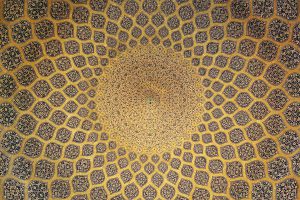A Glimpse into the Life of Faqīh al-Shām Aḥmad b. Muḥammad al-Zurqā

By Mln. Justin Poe (Takmīl Graduate, 2019)
His Lineage and Upbringing
ʿAllāmah Aḥmad b. Muḥammad b. ʿUthmān al-Zurqā was born in the city of Ḥalab, Syria around the year AH 1285 (circa 1869 CE). His father, Muḥammad al-Zurqā, was a distinguished and erudite scholar, known for his standing as a jurist of the Ḥanafī school and his exceptional teaching abilities. Shaykh Aḥmad grew up in his shadow and under his care, benefitting from the academic environment that surrounded him. His studies began with memorizing the Qurʾān and thereafter he progressed and attended lectures in the masājid covering the various Islāmic sciences.
His Early Life and Education
While attending these lessons, Shaykh Zurqā quickly surpassed his peers. He then joined his father’s lectures, which were at a level that was beyond his age but suitable for him as he possessed a sharp mind. After just a short period of time, he became one of his father’s prime students. His father was blessed with good health and a long life, and Shaykh Zurqā continued to attend his lessons for more than thirty years. He quaffed the nectar of these lessons until he quenched his thirst from his father’s fountain of knowledge. The lectures were held in Madrasah Shaʿbānīyah, Jāmiʿ al-Khayr, and the Grand Masjid in Ḥalab. Later, the Shaykh attended his father’s lessons that were conducted at his home after his father reached old age.
The educational system at the time was not one of structured institutes and schools or structured lessons with tiered classes of students. Students, on the contrary, would choose the lessons of the shuyūkh and teachers that they wished to learn from. After the teacher granted a student permission, the student would gather wherever the teacher decided on for the lessons. This is how the Shaykh took knowledge from his father. His education primarily focused on fiqh. Shaykh Zurqā, along with his father’s other students, would accompany his father throughout the day, remaining with him during his entering and exiting class, all the while filling his store of knowledge. Within his father’s own lifetime, Shaykh Zurqā was recognized as one of the most respected jurists of the era.
His Knowledge, Insights, and Academic Interests
Shaykh Zurqā critically studied several central Ḥanafī fiqh texts, commentaries, and fatāwā compilations under his father and others. These texts were analyzed, critiqued, and researched. This method of instruction allowed Shaykh Zurqā to develop a juristic mind and legal acumen until he was able to observe the relationship between uṣūl, qawāʿid, furūʿ, and their application in iftāʾ. These texts included Radd al-Muḥtār (Ibn ʿĀbidīn’s commentary on al-Haṣkafī’s al-Durr al-Mukhtār), Tabyīn al-Ḥaqāʾiq, Badāʾiʿ al-Ṣanāʾiʿ, al-Baḥr al-Rāʾiq, and al-Ashbāh wa al-Naẓāʾir.
When Shaykh Zurqā’s father reached the age of seventy-five, he left his teaching posts. Thereafter, his students and benefactors shifted their attention to Shaykh Zurqā. Thus, he filled his father’s absence and took up his father’s teaching positions.
The Shaykh found his academic interest, as indicated above, in the subject of fiqh and researching aḥkām (trans. juristic rulings). Critically reading and analyzing printed texts and manuscripts in this field was not a mere pastime for him; rather, he consumed the texts while negotiating their contents, just as he had learned from his father. The Shaykh was known, as well, for his focused and precise insight into the nuanced subject of al-furūq, which are those juristic issues that appear to be similar but are in fact different in a subtle way, in addition to his deep understanding of derivative issues (ar. furūʿ) and positive law (ar. masāʾil). As well, the Shaykh had a deep understanding of contract law and its related issues. He was a reliable resource for juridical decisions and evaluating cases that were to be decided by the courts.
After World War One and the French invasion of Syria, the madrasah, al-Khusrufīyah, was established. This school was the first educational institute founded in Ḥalab, in contrast to the previous method of education described above. The Shaykh was appointed as an instructor in Ḥanafī Fiqh in the upper-classes. During this time, he also taught a text that compiled ninty-nine juristic principles (ar. al-qawāʿid al-fiqhīyah al-kullīyah). He later wrote his well-known commentary on these principles, Sharḥ al-Qawāʿid al-Fiqhīyah.
Shaykh Zurqā had a fondness for classical literature, especially poetry. His memory was filled with stories, narrations, and rare lines of poetry. This love of his for Arabic literature and belle-lettres naturally amplified his juristic ability as fiqh and its related sciences since fiqh requires a strong command over language and semantics.
His Library
The Shaykh owned a massive library, filled with varied rare books and prints, original manuscripts, and treasured treatises. This library was a primary source of his vast range of reading. In fact, the fame of this library reached far corners of the Muslim World. Scholars would travel to visit his library. ʿAllāmah Aḥmad Tīmūr Bāshā from Egypt visited it on numerous occasions.
Eventually, the Shaykh sold his entire library to the Public Library of Alexandria, Egypt. The library, with its valuable and unique manuscripts was priceless and therefore caught the attention of book collectors and sellers from around the world. The Shaykh was well-aware of its value – it was priceless in his eyes, but to foreign ambassadors and the consulates of non-Muslim countries, these manuscripts were precious artifacts for Orientalist research, which would be used to exert cultural and political dominance over the Muslim World. The Shaykh knew that he could not protect his library and its contents from calamities, deterioration, and theft so he made the decision to sell it to a capable library for its preservation.
His Character and Demeanor
Shaykh Zurqā was tall, fair-skinned, and awe-inspiring. He was meticulous in his dress, his hair enlightened with white, and he was composed in his gait, sitting, and speech. He was firm in his defense of the truth and refuting falsehood.
Contrary to his formidable physical appearance and manner, he was kind, especially with students, and generally with people, generous, and favored simplicity. He would begin his lessons with fiqh, then proceed to instruction of the manners and decorum of sermons (ar. khuṭab), argumentation (ar. niqāsh), and academic and public gatherings. In these lessons were gems and wisdoms from every angle, academic, literary, and spiritual.
His Academic Impact
Sharḥ al-Qawāʿid al-Fiqhīyah is a unique, exceptional work. The original ninty-nine maxims are taken from the beginning of Majallat al-Aḥkām al-ʿAdlīyah. The commentary is taught today in iftāʾ programs in addition to Ibn Nujaym’s al-Ashbāh wa al-Naẓāʾir and in some cases in place of it. Many years were spent teaching the maxims and this text is a product of the years of teaching, researching, and gathering books and rare points. The text can be thought of as a child of the Shaykh.
Regarding the criticism of books, the Shaykh said: “Be wary of the companion of a single book.” If an author is known to have written only a single text, especially in their later years, this tells the reader that the text is a product of years of editing, revision, self-critique, verifying, and drafting. This fact is well-attested to in all fields. To unscrupulously critique such a work is naïve and evidence of superficial reading and a lack of careful evaluation.
Although this is the only known literary output of the Shaykh, he trained and instructed many students who later became jurists and legal scholars. They became like his books. So, reader, remember that a scholar may not have composed tomes or even a single seminal work, but the dedicated students of the scholar are the pages of the scholar’s lifelong effort.
His Final Days
The Shaykh died in Ḥalab and returned to the company of his Lord in the summer of AH 1357. May Allāh taʿālā send copious compassion and ease upon the Shaykh and accept his efforts and receive him into the gathering of the Prophets, Angels, and righteous.
I relied on the biographical entry of the Shaykh in Shaykh ʿAbd al-Fattāḥ Abū Ghuddah’s Tarājim Sittah min Fuqahāʾ al-Aʿlām al-Islāmī fī al-Qarn al-Rābiʿ ʿAsharah and Shaykh Muṣṭafā Aḥmad al-Zurqā’s (son of Shaykh Aḥmad al-Zurqā) introduction to the first and second print of Sharḥ al-Qawāʿid al-Fiqhīyah.


